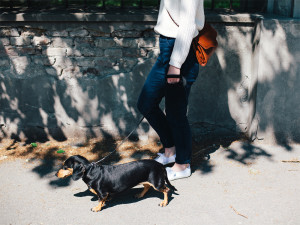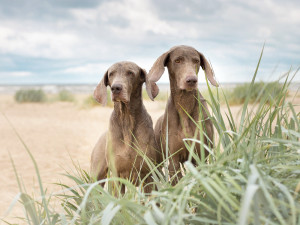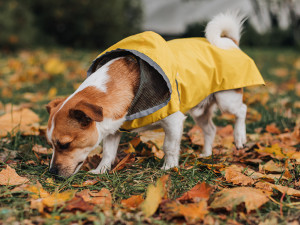Territorial Peeing Habits: How Do You Stop a Dog From Marking?
Please, make it stop.
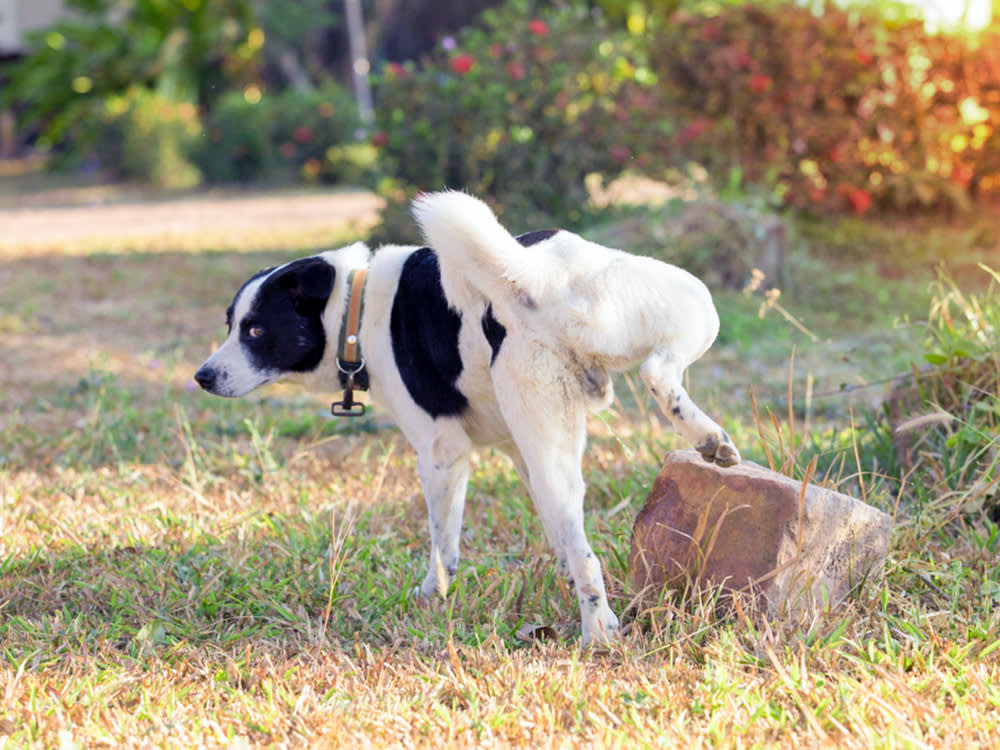
Share Article
In This Article:
Why Do Dogs Mark Their Territory? Dog Marking vs Peeing: How to Tell the Difference How to Stop a Dog From Marking? Frequently Asked Questions
When we are little, we’re taught during potty training that it’s frowned upon to pee or poop outside of a toilet. When our dogs are potty trained, they may learn that they need to go outside, but they don’t necessarily always learn not to mark their territory (inside the house or out). If you are still dealing with a dog who marks things they shouldn’t, there is a way to make it stop. Learn more here.
Why do dogs mark their territory?
To dogs, marking is a natural behavior. Territorial marking allows your dog to set boundaries in their area. Marking also provides a lot of information to other dogs. The scent can give information about their age, sex, altered/ unaltered, healthy/sick etc. Unfortunately, marking can be a nuisance behavior to humans depending on where or when your dog is doing it. Many factors may cause your dog to mark. Finding out why your dog is marking can help you put an end to the behavior.
Visitors
Having visitors in your home may cause your dog to mark furniture. This change to your dog's environment may create anxiety or stress for your dog. New visitors may also bring different scents into the homes of other animals. Your dog may not like having their environment disrupted by a new visitor, especially one who smells like other dogs. Your dog may begin to mark territory to show that it is theirs.
How much do you spend on your pet per year?

Did your visitors bring another animal with them? When bringing another dog into your home, it is always a good idea to meet outside on neutral territory. I like to take my dogs on a walk with new dogs. I do not allow them to meet initially. We walk with enough distance that they can see each other but can not reach each other. I let one go first, and then the other follows, sniffing where that dog walked/ marked. Then, we switch positions and allow the other dog to walk first. This allows the dogs to get to know each other’s scent before meeting.
As the walk goes on, the dogs should get looser body language and become more calm walking near a new dog. It is best to let dogs meet on a loose leash, not a tight one. I recommend using a long line in this situation (be sure you are holding the end in case you need to separate the dogs).
Neutering/spaying
Is your dog altered or unaltered? Dogs that have not been spayed or neutered may be more likely to mark territory. These unaltered dogs may have a stronger sense of territorial behavior that comes along with the hormones from still being intact.
Male and female dogs can mark, but male dogs are more likely to do so. Talk to your vet when would be the best time to spay/neuter your dog. Dogs can be spayed/neutered at any time, but as they get older, there are more chances of complications. If you spay/neuter around six months, your dog may stop some territorial marking once they are healed. Spaying and neutering does not always help; it depends on the reason your dog is marking.
Environment change
Dogs thrive off stability and routine. A change in routine or their environment can cause anxiety or stress for your dog, which may cause them to begin marking. Environmental changes can be anything that causes your pup undue discomfort moving furniture around, moving to a new home, construction work happening outside, a new animal moving in next door, switching their food, etc.
If there is an environmental change, like moving, try to keep your dog’s routine the same — walk them and feed them at the same time. If you are starting a new job with different or longer hours, have someone come walk them when you normally would. For loud noises, you can play a sound machine to help drown out the sound. If you are bringing new furniture into the house, block it off from your dog for the time being. As you sit on the furniture, it will get your scent on it. Then you can slowly introduce it to your dog under supervision.
Stress
If you notice unusual marking and think your dog is stressed, seek the assistance of your veterinarian right away. Could there be an animal taunting your dog from the window? Did you add a new baby or pet to the home? Do your best to observe your dog. Are you noticing them acting any differently? When is the marking happening? What happened right before they marked? Is it always happening when you are out of the house? Stress can be detrimental to dogs, and trying to get your dog help right away is best. Your veterinarian will be able to point you in the right direction for treatment.
Breed
Certain breeds are more likely to mark than others. Dogs who are bred to use their nose for hunting, like Beagles, may be more prone to marking. It is always best to do your research before bringing a dog home. Looking into certain breeds and learning about them will help you pick the best companion to spend your life with.
Illness
Any unusual accidents are a red flag to bring your dog to the vet. Other red flags: if you notice your dog going pee more frequently, the urine has a funky smell, or they are marking or having accidents in the house. These unusual habits are cause for concern. Your dog may have an issue with their kidneys, a UTI, diabetes, bladder stones etc. Your vet will be able to do tests to help pinpoint any issues and help treat your dog.
Dog marking vs. peeing: How to tell the difference
Typically, the main difference between marking and peeing is the amount. If a dog is going pee, there will be a significant amount of urine because they are emptying their bladder. If a dog is marking, there will be a small amount of pee.
How to stop a dog from marking?
Stopping a dog from marking in the house is a difficult task, but it can be done with patience. First, you will need to figure out why your dog is marking. Illness, stress, environmental changes, or breed can be some of the reasons. Very young puppies will not mark because they do not have the hormones in their body that tell their bodies to mark yet. If you have a very young puppy who is peeing in the house, they are more likely not potty trained, and you will want to start potty-training techniques.
Neuter/spay your dog
Neutering or spaying your dog can help with territorial marking. If you have a dog under a year old, spaying or neutering should help decrease the marking behavior. Once your dog is fixed, it may take a month or so to see the results. If your dog is older and has spent many years of their life marking, spaying and neutering may not help. It is dependent on the dog and the reason they are marking.
Encourage outdoor marking
Take scent walks. They are a great way to encourage your dog to mark in appropriate places. Allowing your dog to fulfill natural dog behaviors in an appropriate way will help prevent them from repeating behaviors in an unwanted way. On a scent walk, you allow your pup to mark and sniff wherever they want. Not only does this type of walk allow them to mark, it allows them to engage in their natural searching behaviors, which will tire out their brains.
Increase potty breaks
Allowing more frequent pee breaks can help prevent some marking, especially if it is due to an illness. Observe your dog when they are peeing outside. That way, you know if they went, can see if they are straining, or check if the pee is discolored or smells unusual.
Clean marked areas
Cleaning the area where marking happened is extremely important. When using a cleaner, be sure to use something that is ammonia free. Urine contains ammonia, so if you use a cleaner with ammonia, the spot will continue to smell, which tells your dog to continue to mark there. Be sure to treat any carpets and do your best to get rid of all of the urine. Blot up as much liquid as you can before treating it with a cleaning solution.
Crate-training
It is always important for a dog to be crate-trained. Crates are a great way to keep your house and your dog safe. If your dog ever has to spend any time at the vet, they will need to be in a crate. If your dog is not crate-trained, this will be another added stressor.
If your dog is already comfortable with being in a crate it will help them feel more comfortable while at the vet. Crate-training is also a great way to prevent unwanted accidents. Dogs do not typically pee where they sleep, so most dogs do not pee in their crates. If your dog is having accidents, placing them in the crate when you can not keep an eye on them will prevent them from peeing.
FAQs
How to train a puppy to pee outside?
Begin by taking your puppy outside every 30 minutes. Each time they pee, reward them with a yummy treat. Be sure to take your puppy to the bathroom five to 10 minutes after eating, playing, or sleeping (outside of taking them out on their 30-minute schedule). If your puppy has an accident, do not punish them for it. Just clean it up and move on. If you catch your puppy in the middle of peeing inside, stop them and take them right out to their potty area.
How to crate train a puppy?
Begin by feeding the puppy every meal in their crate. One of the most important steps of crate-training is allowing your puppy time in the crate while you are around. Start with small increments. Put your puppy in the crate while you watch TV. Then let them out after five minutes, and keep making the duration a bit longer as they are successful and comfortable.
If you only put your puppy in the crate when you leave them, the crate will become a negative space, but if you place them in there while you are relaxing they will learn to relax too. Putting your puppy in the crate after a walk or a play session is a great time to practice relaxation because they will be tired. Give your puppy short bursts of alone time in the crate, give them a Kong to lick, and let them out when they are done.
Why does my dog pee when I pet them?
Unfortunately, some dogs pee when they are excited, which is why they may pee when you pet them. Some dogs may also pee submissively when greeted by someone who makes them nervous. If you know your dog pees when you have visitors try to take them outside before visitors come over or have them meet the visitor outside so the accident happens there and then walk in the house together.
Why does my dog pee on other dogs?
I have found that my dogs typically pee on one another by accident. One dog is marking an area, and the other dog is distracted by a scent and walks right under the dog who is peeing. Your dog may also pee on another dog when they feel like the other dog is invading their territory. This behavior should be addressed with a dog trainer as soon as possible, as it may lead to other issues.
References
Hart, Benjamin L. “Environmental and Hormonal Influences on Urine Marking Behavior in the Adult Male Dog.” Behavioral Biology, vol. 11, no. 2, June 1974, pp. 167–176, https://doi.org/10.1016/s0091-6773(74)90321-6opens in new tab. Accessed 4 Oct. 2020.
McGuire, B., et al. “Urine Marking in Male Domestic Dogs: Honest or Dishonest?” Journal of Zoology, vol. 306, no. 3, 25 July 2018, pp. 163–170, https://doi.org/10.1111/jzo.12603opens in new tab.
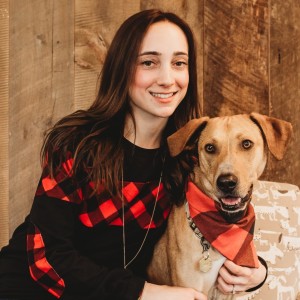
Danielle Vrabel, CPDT-KA
Danielle Vrabel is a dog trainer who earned her CPDT-KA in 2020. Danielle is a proud pet mom of five pets: two dogs, two cats, and a corn snake. Danielle has fostered over ten dogs and fifteen cats and kittens, as well as helped train shelter dogs before they are adopted. Both of Danielle’s dogs are pet therapy dogs, where she also volunteers her time helping evaluate future therapy dogs.
Related articles
![Woman walking her small black dog outside on leash.]()
Do Small Dogs Pee More Often?
Research shows that little dogs may feel the need to scent mark more frequently than big dogs.
Why Does My Puppy Pee on My Bed?
And when will it stop?
Why Does My Dog Scratch My Bed Sheets?
Male vs. Female Dogs: Are There Any Real Differences?
World-renowned behaviorist Patricia McConnell explains.
Why Does Your Dog Scratch the Carpet?
That is not a toy.
![Jack Russell Terrier in a yellow raincoat walks through the autumn park.]()
Dogs’ Sense of Smell: What Can Dogs Smell?
There’s a reason that sweet little nose is always pressed to the ground.



